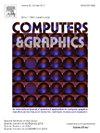独舞视频中的二重唱舞蹈
IF 2.8
4区 计算机科学
Q2 COMPUTER SCIENCE, SOFTWARE ENGINEERING
引用次数: 0
摘要
介绍了一种从输入独舞者的视频表演中生成二人转视频的方法。为了解决这个新问题,我们的系统处理了一组子任务,包括舞者分割、摄像机运动处理、舞台重建和复杂的几何约束管理,如舞者规模保存和舞者碰撞预防。建议的方法利用现有的方法和新的解决方案。值得注意的是,我们直接解决了2D时空中的碰撞问题,而不是传统的3D方法。我们修改舞者的初始位置,以避免长时间的整体碰撞,同时也通过故意减速或加速动作来调节舞蹈的速度,以避免局部的短暂碰撞。实验结果证明了该方法的有效性。用户研究表明,该系统不仅成功地合成了引人入胜的双人舞序列,而且保持了个人表演的真实性。本文章由计算机程序翻译,如有差异,请以英文原文为准。

Duet dancing from a solo dance video
This paper introduces a method to generate duet dance videos from an input solo dancer’s video performance. Addressing this novel problem, our system tackles a set of sub-tasks, including dancer segmentation, camera motion handling, stage reconstruction and the intricate management of geometric constraints such as dancer scale preservation and dancers collision prevention. The proposed approach leverages existing methodologies and new solutions. Notably, we address collisions in 2D space–time directly, departing from traditional 3D approaches. We modify the initial location of the dancer to avoid long-time collisions globally, while also modulating the pace of the dance by deliberate slowing down or accelerating motion to avoid short collisions locally. Experimental results attest to the efficacy of our approach. The system not only successfully synthesizes engaging duet dance sequences but also upholds the authenticity of individual performances, as shown by a user study.
求助全文
通过发布文献求助,成功后即可免费获取论文全文。
去求助
来源期刊

Computers & Graphics-Uk
工程技术-计算机:软件工程
CiteScore
5.30
自引率
12.00%
发文量
173
审稿时长
38 days
期刊介绍:
Computers & Graphics is dedicated to disseminate information on research and applications of computer graphics (CG) techniques. The journal encourages articles on:
1. Research and applications of interactive computer graphics. We are particularly interested in novel interaction techniques and applications of CG to problem domains.
2. State-of-the-art papers on late-breaking, cutting-edge research on CG.
3. Information on innovative uses of graphics principles and technologies.
4. Tutorial papers on both teaching CG principles and innovative uses of CG in education.
 求助内容:
求助内容: 应助结果提醒方式:
应助结果提醒方式:


